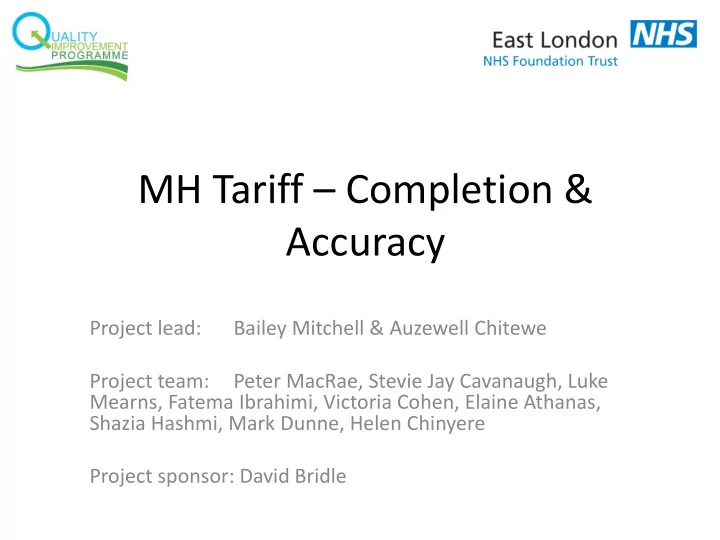

MH Tariff – Completion & Accuracy Project lead: Bailey Mitchell & Auzewell Chitewe Project team: Peter MacRae, Stevie Jay Cavanaugh, Luke Mearns, Fatema Ibrahimi, Victoria Cohen, Elaine Athanas, Shazia Hashmi, Mark Dunne, Helen Chinyere Project sponsor: David Bridle
Background • Why you chose this project… Allocating all service users to care clusters in a timely and accurate manner is essential for the Trust to maintain financial viability going forward. It is also important in determining the effectiveness of the care we provide and in benchmarking across services and providers. We identified a clear need and room for improvement. • What was the problem? Following a significant change in process and service redesign the previous method of clustering was no longer sustainable. Expired and Awaiting Clusters increased well beyond agreed thresholds and a solution was urgently needed. • Project aim To have no more that 5% expired or awaiting cluster cases by 1 st of April 2015. Further, to increase accuracy of clustering to a minimum of 80% by April 2016.
Targeted Training, speficic to team environment Training - Data Entry Consultant specific training - Scoring & Pathway Changes Knowledge Engagement of qualified staff in HoNos scoring and cluster recommendations Ensure basic RiO training Skills Variation and computer skills training for all staff Local engagement with RS. Local team level process to prompt clustering. Right Information, Right Time Bi-monthly and then monthly catch all reporting Complete & Accurate Care from Q&P Clustering Systems in Place Development of ward and Simplified process community specific regardless of environment processes Ensure develped processes Time are efficient Data Accuracy Ensure RS dashbaord MH Tariff Dashboard presents the correct data in a consumable fashion Centralised system removes Tranisition from central ownership from local teams ownership to local focus on (relationship to clinical work clustering as part of the Attitude non-existant) clinical process Belief regarding the Promote importance of MH likelyhood or validity of the Tariff use and its connection system going forward to funding streams.
Sequence of PDSA’s – for one change idea or secondary driver Cycle 5 : “How to record clustering information in RiO ” training video Cycle 4 : Community and inpatient engagement – different strategies A P needed S D Cycle 3 : Test clustering & RiO recording intervals with admin and clinicians Cycle 2 : Familiarise teams with new tool and A P modify tool following feedback S D Cycle 1: Transition from a local manual process to the creation of a more reliable centralised fit for purpose tool
Expired Cluster Measure Run Chart Median 20% 18% 16% Clustering 14% Tool Design 12% 10% 8% 6% Clustering Tool 4% Implementation 2% 0% Apr-14 May-14 Jun-14 Jul-14 Aug-14 Sep-14 Oct-14 Nov-14 Dec-14 Jan-15 Feb-15 Mar-15
Awaiting Cluster Measure Run Chart Median Service Redesign 6% Clustering Tool Design 5% 4% Clustering Tool 3% Implementation 2% 1% 0% Apr-14 May-14 Jun-14 Jul-14 Aug-14 Sep-14 Oct-14 Nov-14 Dec-14 Jan-15 Feb-15 Mar-15
Daily Collection
Learning What did we learn? New ways to interpret data. Local DMT level ownership of QI was likely a major contributor to the significance of the improvement. Engagement at all levels of the process has improved and the changes put in place allowed teams to take more direct responsibility for their own data. One of the benefits of the new process is the permission it gives for you to fail. 80/20 rule – by focusing on the teams with the largest potential impact, greater global gains were achieved. Challenges: Assuring senior stakeholders that improvement would be made but that QI takes time. Building the will amongst staff that have doubts about the value of Clustering as well as QI methodology. Sustaining the gains achieved – though results were maintained for a significant period of time, when the reporting services tool suffered down time during the RiO merge performance dropped.
What next? • What will you be doing in your project next? Video tutorial for direct clinician clustering, initially to be ward focused. Greater involvement of care coordinators in clustering clients on their caseloads. • How will you be applying your improvement skills next? Further expansion to other teams in the directorate and inclusion of representatives in overall QI project. Spreading understanding of data through QI techniques to other scenarios.
Recommend
More recommend